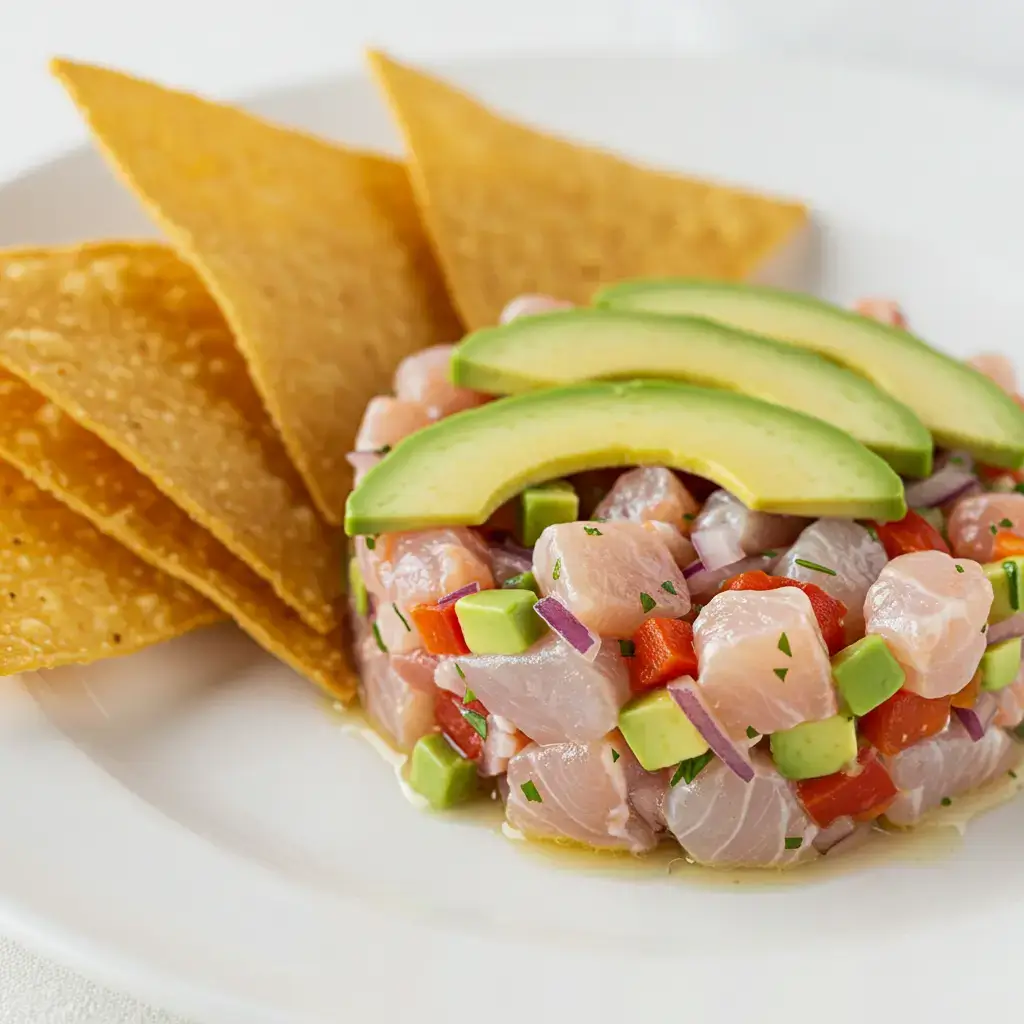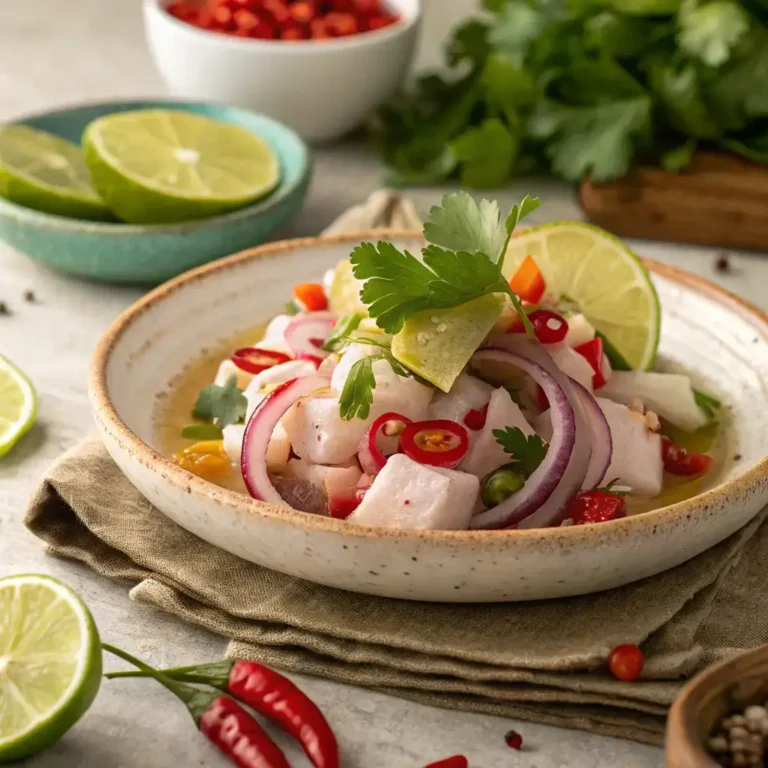Ceviche Description in Spanish: A Zesty Dive Into Latin Flavor
Ceviche description in Spanish is more than just a translation—it’s a full-sensory experience. Picture the tang of fresh lime, the sea-sweet taste of just-caught fish, and the crunch of red onion. That’s ceviche. And in Spanish, it comes alive with words like fresco, ácido, and sabroso. Whether you’re a language learner, home cook, or just curious about Latin cuisine, this guide will help you describe, prepare, and enjoy ceviche the way it’s meant to be understood: con sabor y alma.
We’ll explore how ceviche is explained in different cultures, how to say it in French, and how to master the key Spanish words to bring the dish to life.

Table of Contents
What is Ceviche and Why It Matters
The Roots of Ceviche: From the Coast to Your Table
Ceviche description in Spanish is rooted in history, flavor, and coastal tradition. This beloved dish dates back centuries, with its origin often tied to Peru but cherished across Latin America. At its core, ceviche is raw fish or seafood cured in citrus—usually lime—then mixed with red onion, cilantro, and chili. The classic ceviche description in Spanish is pescado crudo marinado en jugo de limón, a phrase that brings out both the process and the freshness behind the dish.
There’s no fire in ceviche—only acid. This “cold cooking” technique, common in Spanish-speaking cultures, is what makes it so distinct. When someone offers a ceviche description in Spanish, they’re not just listing ingredients—they’re painting a picture of oceanside markets, summer evenings, and handmade care.
You’ll often hear terms like jugoso (juicy), picante (spicy), and refrescante (refreshing) in traditional ceviche descriptions. Variants like “ceviche de camarón” are also common, especially in Ecuador, echoing the texture and flavor of this chilean-ceviche that fuses citrus and heat.
Why Ceviche Is a Cultural Icon in Spanish-Speaking Countries
To truly understand ceviche, you need to understand the language used to describe it. In Mexico, you might find a tomato-based twist; in Peru, the lime leads. But across the board, the ceviche description in Spanish always circles back to freshness, simplicity, and soul.
Spanish vocabulary is rich with sensory emotion. Words like tierno, ácido, sabroso, and ligero don’t just describe food—they evoke it. That’s what makes learning ceviche description in Spanish so meaningful for food lovers, travelers, and language learners alike.
Ceviche Description in Spanish
Common Words and Phrases to Describe Ceviche in Spanish
If you want to master ceviche description in Spanish, it starts with sensory vocabulary. Ceviche isn’t just cold fish—it’s zesty, fresh, and bright. Spanish offers a vivid way to express that.
Here are essential words:
- Fresco – fresh
- Ácido – acidic
- Picante – spicy
- Marinado – marinated
- Ligero – light
- Refrescante – refreshing
- Tierno – tender
- Sabroso – flavorful
Put together, a typical ceviche description in Spanish might be: Un plato frío, ácido y fresco de pescado marinado en limón, acompañado de cebolla morada, cilantro y ají. It’s concise, flavorful, and culturally rich.
Regional variations add more color. In Peru, you might hear ceviche clásico con leche de tigre, referencing the citrus marinade. In Mexico, it could include jitomate (tomato) and aguacate (avocado). These descriptions reflect local identity.
Just like in the ceviche-food-description, Spanish food vocabulary is layered. It doesn’t just describe texture—it reveals tradition and emotion.
How to Write or Say a Ceviche Recipe in Spanish
When writing or speaking a ceviche recipe in Spanish, clarity matters—but so does rhythm. Spanish food writing flows like storytelling. Start with verbs: Corta, mezcla, marina, sirve. For example:
Corta el pescado en cubos pequeños. Marina en jugo de limón por 30 minutos. Agrega cebolla, cilantro y ají al gusto.
This kind of language is simple but powerful. It’s perfect for menus, cooking classes, or Spanish food blogs.
Need to pair it? Mention ceviche description in Spanish alongside dishes like chilean-ceviche, or add terms like acompañado de plátanos fritos (served with fried plantains).
Learning ceviche description in Spanish isn’t just translation. It’s an invitation to savor and share the culture behind the words.
Global Vocabulary – Saying Ceviche in Other Languages
What is Ceviche in French?
Ceviche crosses borders easily—but its essence shifts with each language. In French, it’s typically referred to as “le ceviche”, pronounced similarly but with that soft Parisian flair. While not native to French cuisine, ceviche appears on many French menus, especially in fusion or upscale restaurants.
A typical French menu might read: Ceviche de bar aux agrumes et coriandre—which translates to “sea bass ceviche with citrus and coriander.” Notice how the focus remains on elegance and simplicity, but some descriptive terms change. Instead of “picante,” you’ll see épicé (spicy). Acide replaces “ácido.”
Though French lacks the regional ties of Latin America, chefs still aim to preserve ceviche’s character. That’s where the ceviche description in Spanish offers more depth—it carries history, not just flavor.
Explaining Ceviche to Non-Spanish Speakers
So, how do you explain ceviche if Spanish isn’t their language?
Start with the concept: it’s raw seafood “cooked” in citrus juice. That’s simple enough. But to really explain it, try comparing it to sushi or carpaccio—foods that use minimal heat, emphasizing freshness.
Then layer in emotion. Use your ceviche description in Spanish as a bridge: “In Spanish, it’s called pescado marinado en limón. It’s light, acidic, and usually spicy.” Suddenly, you’re not just translating—you’re sharing culture.
Many English speakers find ceviche intriguing but unfamiliar. That’s where your words matter. Phrases like “zesty lime,” “chili heat,” and “cool textures” help paint a picture. If you’re describing a menu or writing about it online, draw from both languages for a full, mouthwatering explanation.
And remember—every time you use a thoughtful ceviche description in Spanish, you connect readers or diners with a dish that’s alive with meaning.
Bringing Ceviche to Life at Home

How to Teach or Translate Ceviche for Cooking Classes or Menus
Whether you’re teaching a bilingual cooking class or creating a menu for a Latin-themed supper club, using an accurate ceviche description in Spanish can elevate the experience. Start by identifying key terms your audience will encounter. Words like marinar, ácido, crudo, and cortar en cubos are essential.
If your students or readers aren’t fluent, create a side-by-side list of Spanish and English terms. This helps them associate language with technique. For example:
- Pescado blanco – white fish
- Ají picante – spicy chili
- Cebolla morada – red onion
- Zumo de lima – lime juice
Using a proper ceviche description in Spanish also reinforces cultural respect. You’re not just translating—you’re presenting the dish as it’s celebrated across Latin America.
Ceviche Variations You Can Make Right Now
Ceviche is flexible, and so is the language used to describe it. Seasonal versions let you experiment while practicing vocabulary. Try using shrimp, scallops, or even mango as a twist. As long as you preserve the citrus cure and crisp vegetables, it’s still ceviche.
When you write or speak about your version, include your own ceviche description in Spanish to make it personal. Say something like: Mi ceviche lleva camarón, mango, jugo de lima, cebolla, y un toque de jalapeño. This tells your story and teaches others.
Want to go deeper? Explore related dishes on the seafood guides, where recipes often echo ceviche’s bright, fresh flavors—even when they aren’t raw. This helps reinforce vocabulary and flavor pairing.
No matter how you serve it, a well-phrased ceviche description in Spanish adds cultural authenticity and culinary charm. It makes the dish not just something to eat—but something to understand and share.

Conclusion: A Dish, A Language, A Story
For me, ceviche is more than lime and fish—it’s memory on a plate. I first tasted it in New Orleans, but I understood it years later while learning to speak—and cook—in Spanish. That’s the beauty of a dish like this. When you master the ceviche description in Spanish, you’re not just learning words—you’re learning history, culture, and connection.
Whether you’re serving it seaside or in your own kitchen, ceviche invites us to pause and savor. And with the right words, you can bring its spirit to life in any language.
For More Recipes Follow Me : PINTEREST
FAQ: Answering Your Ceviche Questions
How to explain ceviche?
Ceviche is a dish made from raw fish or seafood, “cooked” in citrus juice, usually lime. It’s combined with onions, chili, and herbs for a zesty, refreshing flavor. The acid in the citrus denatures the proteins, giving the seafood a firm texture—no heat needed.
What is ceviche?
Ceviche is a Latin American seafood dish typically made with white fish, lime juice, red onion, chili, and cilantro. It’s served cold and often accompanied by corn, plantain chips, or avocado. It’s popular in Peru, Mexico, Ecuador, and Colombia, among others.
What is ceviche in Spanish?
In Spanish, ceviche is still called ceviche. The ceviche description in Spanish might read: pescado crudo marinado en jugo de limón, servido con cebolla, ají, y cilantro. It translates to: raw fish marinated in lime juice, served with onion, chili, and cilantro.
How do you say ceviche in French?
In French, it’s written as le ceviche and pronounced similarly. It’s described as poisson cru mariné dans du jus d’agrumes, or raw fish marinated in citrus juice. Though not native to French cuisine, ceviche has become a trendy dish in modern French restaurants.

Ceviche Description in Spanish: A Zesty Dive Into Latin Flavor
Ingredients
Method
- 1. Corta el pescado en cubos pequeños.
- 2. Exprime el jugo de limón y vierte sobre el pescado.
- 3. Deja marinar por 30 minutos hasta que el pescado cambie de color.
- 4. Agrega cebolla, ají y cilantro.
- 5. Sazona con sal y pimienta.
- 6. Sirve frío, acompañado de chips o plátano frito.







